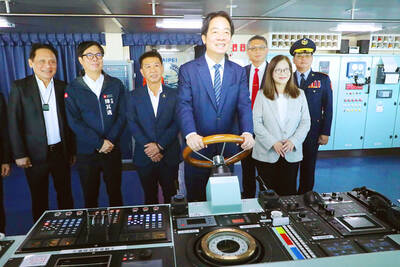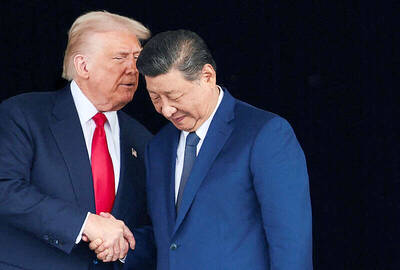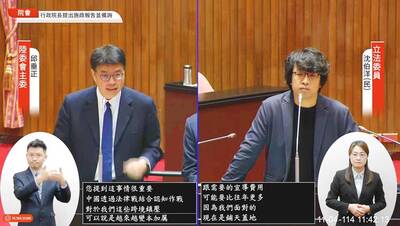The National Health Insurance Bureau (中央健保局) said yesterday that it would begin replacing health insurance identification cards made of paper with integrated circuit (IC) cards next year.
The bureau says the new cards will be more convenient and save the government money.
Health officials briefed President Chen Shui-bian (
According to the bureau, the trial replacement of the cards would
begin next July in Taipei, Penghu, Taichung and Kaohsiung. The scheme is expected to be fully implemented nationwide in May of 2003.
The new cards will digitally integrate medical certificates that authorize patients with disabilities or serious illness for a higher level of coverage. They will also permit easier access to medical records, but how this will be done and the privacy issues involved have yet to be hashed out.
Moreover, users will no longer have to replace their cards after making six visits to the hospital or clinic. Currently, those people enrolled in the National Health Insurance Plan have to replace their cards because the cards run out of stamp space after six visits.
The bureau estimated that by adopting IC cards and eliminating the frequent replacement of paper cards, it could save the bureau NT$40 billion over five years.
Chen gave a brief speech at the association meeting urging medical professionals to help the government ensure the continuous operation of the National Health Insurance Plan by efficiently managing medical resources and educating their patients about the proper reasons for seeking medical attention.
The Department of Health began to reform the health insurance plan last year and set up a special taskforce for that purpose in July, said Minister of Health Lee Ming-liang (
"The first thing the team is responsible for is exploring the public consensus on whether the National Health Insurance Plan is to make available social insurance or to create a social security mechanism," said Lee.
Lee was highlighting the public's belief that the National Health Insurance Plan is unlimited.
"If the consensus advocates that the plan is simply for insurance, the public must then be educated to realize that the benefit of insurance coverage is limited. Otherwise they will have to pay higher taxes to make the plan part of Taiwan's social security network," the minister said.
"Many people incorrectly regard the National Health Insurance Plan as a social security mechanism, wanting the insurance to cover every medical service but rejecting the upward adjustment of premiums," Lee said.
The health insurance premium has stood at 4.25 percent of monthly salarie since the government began to collect it in 1995.
"But the insurance is actually designed to provide essential health care rather than health care for everything and everyone."
The insurance plan has suffered a monthly deficit of NT$2 billion, on average.
People visited outpatient clinics an average of 14.6 times in 1999, which was higher than many other developed countries.

CALL FOR SUPPORT: President William Lai called on lawmakers across party lines to ensure the livelihood of Taiwanese and that national security is protected President William Lai (賴清德) yesterday called for bipartisan support for Taiwan’s investment in self-defense capabilities at the christening and launch of two coast guard vessels at CSBC Corp, Taiwan’s (台灣國際造船) shipyard in Kaohsiung. The Taipei (台北) is the fourth and final ship of the Chiayi-class offshore patrol vessels, and the Siraya (西拉雅) is the Coast Guard Administration’s (CGA) first-ever ocean patrol vessel, the government said. The Taipei is the fourth and final ship of the Chiayi-class offshore patrol vessels with a displacement of about 4,000 tonnes, Lai said. This ship class was ordered as a result of former president Tsai Ing-wen’s (蔡英文) 2018

‘SECRETS’: While saying China would not attack during his presidency, Donald Trump declined to say how Washington would respond if Beijing were to take military action US President Donald Trump said that China would not take military action against Taiwan while he is president, as the Chinese leaders “know the consequences.” Trump made the statement during an interview on CBS’ 60 Minutes program that aired on Sunday, a few days after his meeting with Chinese President Xi Jinping (習近平) in South Korea. “He [Xi] has openly said, and his people have openly said at meetings, ‘we would never do anything while President Trump is president,’ because they know the consequences,” Trump said in the interview. However, he repeatedly declined to say exactly how Washington would respond in

WARFARE: All sectors of society should recognize, unite, and collectively resist and condemn Beijing’s cross-border suppression, MAC Minister Chiu Chui-cheng said The number of Taiwanese detained because of legal affairs by Chinese authorities has tripled this year, as Beijing intensified its intimidation and division of Taiwanese by combining lawfare and cognitive warfare, the Mainland Affairs Council (MAC) said yesterday. MAC Minister Chiu Chui-cheng (邱垂正) made the statement in response to questions by Democratic Progressive Party (DPP) Legislator Puma Shen (沈柏洋) about the government’s response to counter Chinese public opinion warfare, lawfare and psychological warfare. Shen said he is also being investigated by China for promoting “Taiwanese independence.” He was referring to a report published on Tuesday last week by China’s state-run Xinhua news agency,

‘ADDITIONAL CONDITION’: Taiwan will work with like-minded countries to protect its right to participate in next year’s meeting, the foreign ministry said The US will “continue to press China for security arrangements and protocols that safeguard all participants when attending APEC meetings in China,” a US Department of State spokesperson said yesterday, after Beijing suggested that members must adhere to its “one China principle” to participate. “The United States insists on the full and equal participation of all APEC member economies — including Taiwan — consistent with APEC’s guidelines, rules and established practice, as affirmed by China in its offer to host in 2026,” the unnamed spokesperson said in response to media queries about China putting a “one China” principle condition on Taiwan’s